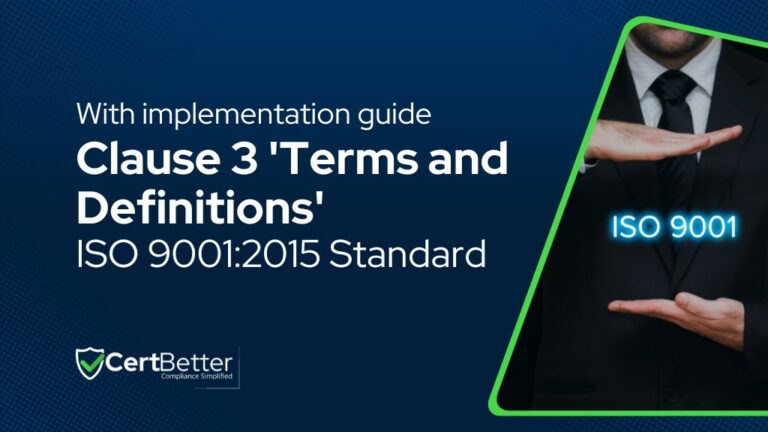Understanding Clause 3 Terms and Definitions of ISO 9001 2015 With Examples

Let’s talk about Clause 3, the ‘Terms and Definitions’ part of the ISO 9001:2015 standard. This clause is more important than it might initially seem. Imagine it as the dictionary of ISO 9001:2015.
When everyone speaks the same language, it’s much easier for you to implement and maintain your Quality Management Systems (QMS). It ensures that when the standard mentions a term like “record” or “document,” you know exactly what it’s referring to. This is crucial for you because it eliminates any confusion.
By understanding these definitions, you’re laying a solid foundation to build the rest of your quality management practices on.
Let’s take a closer look at Clause 3 of ISO 9001:2015, focusing on its role in QMS and the significance of terms and definitions.
Purpose of Terms and Definitions in ISO 9001:2015
By providing clear and precise definitions for key terms, Clause 3 in ISO 9001:2015 ensures that everyone involved in your quality management system is on the same page.
This clarity is crucial for effective communication across different departments and external parties.
For instance, terms like ‘customer satisfaction‘ or ‘quality management‘ might seem straightforward, but in the context of ISO 9001, they have specific meanings.
Understanding these definitions helps you align your business practices with the standards set by ISO.
This alignment is vital not just for maintaining consistency in your internal processes but also for ensuring that external audits and certifications go smoothly.
Why do Terms and Definitions Matter?
When you and your team use the same terms with the same meanings, it significantly reduces the risk of misunderstandings or errors. This unified language becomes even more important when dealing with international partners or suppliers, where differences in terminology can lead to confusion.
Clear communication is the cornerstone of any effective quality management system.
Clause 3 ensures this by providing a universal language for quality management.
Moreover, the impact of these terms and definitions on compliance and implementation cannot be overstated. They guide you in structuring your QMS in a way that meets standards, which is essential for ISO certification.
Understanding these terms also helps you to accurately interpret the other clauses of ISO 9001:2015, ensuring that your implementation efforts are aligned with the standard’s requirements.
Essentially, by mastering the language of ISO 9001, you’re setting yourself up for a smoother journey towards achieving and maintaining compliance.
Common Terms in Clause 3 and Their Meanings
Let’s dive into some of the common but important terms in Clause 3 of ISO 9001:2015, offering you a detailed explanation and illustrating their application in business contexts.
Context of the Organization — This term refers to internal and external factors that affect an organization’s ability to meet the requirements of its QMS. For example, in your business, this could include market trends, regulatory changes, competitive landscape, or internal resources and capabilities. Understanding your organization’s context is vital for designing a QMS that is responsive and relevant to your specific situation.
Interested Party — Often misunderstood, this term refers to an individual or group that can affect, be affected by, or perceive themselves to be affected by a decision or activity of the organization. For instance, your suppliers, employees, customers, and even regulatory authorities are interested parties. Recognizing and managing their needs and expectations is a key component of an effective QMS.
Quality Management System (QMS) — This term refers to the framework of processes, procedures, and responsibilities used to achieve quality policies and objectives. In your business, a QMS could involve processes like customer feedback mechanisms, quality control checks, and continuous improvement practices. It’s essentially the system you put in place to ensure your products or services consistently meet customer requirements and regulatory standards.
Risk-Based Thinking — This is a central aspect of ISO 9001:2015. It means considering the risk and opportunities associated with the context and objectives of the organization. For example, in your business, this could involve assessing the risks of a new supplier or the opportunities presented by a new market trend. Risk-based thinking is crucial for proactive management and ensuring the sustainability of the QMS.
Performance Evaluation — This refers to monitoring, measuring, analyzing, and evaluating the performance of the QMS. It’s not just about tracking if processes are followed, but also if they are effective and if objectives are being met. In practical terms, this might involve regular reviews of customer feedback, internal audits, or performance metrics.
Customer Satisfaction — Beyond simply meeting client needs, this term encompasses the expectation of delighting customers. For instance, if you run a manufacturing business, customer satisfaction isn’t just about delivering products on time; it’s also about the quality, after-sales service, and overall customer experience.
Documented Information — This term replaces what were previously called ‘documents’ and ‘records’. Documented information refers to any information that your QMS needs to be controlled and maintained. In practice, this could be your quality manual, process maps, policies, or even emails that provide evidence of processes being followed.
Internal Audit — An internal audit isn’t just a routine check of operations; it’s a thorough, systematic review, often done by someone from your own team or an external ISO consultant. The main goal is to ensure your business practices align with what you’ve set out in your policies and procedures – it’s about walking the talk.
Nonconformity — This refers to a deviation from a standard, a customer requirement, or an expectation. For example, if a product fails a quality test, it’s a nonconformity. Identifying and addressing nonconformities is crucial for maintaining the integrity of your QMS.
Corrective Action — Often confused with ‘nonconformity’, corrective action is actually the step taken to eliminate the causes of detected nonconformities to prevent recurrence. For instance, if a product defect is identified, corrective action would involve not only fixing the specific issue but also modifying the process to prevent similar defects in the future.
Continual Improvement — This is an ongoing effort to enhance your QMS. It’s about making incremental changes to improve processes and increase efficiency. In a business setting, this could mean regularly reviewing customer feedback to improve your product or service.
As you can see they’re a bit confusing, but rest assured, they represent key concepts that underpin the entire ISO 9001:2015 standard. Let’s see how to actually apply these terms and definitions to your business.
How to Apply Clause 3 in Your Organisation
Applying Clause 3 Terms and Definitions of ISO 9001:2015 in your organisation involves understanding and implementing the standard’s terminology into your everyday business.
To achieve this, there are two main pathways you can consider:
Adherence to Standard Terms — This involves directly incorporating the ISO terms like internal audit and management review as defined in the standard into your business processes and communications. It ensures uniformity and might simplify external audits and compliance checks.
Adapting to Your Business Language — If the standard terms feel too technical or out of sync with your organisational culture, you can translate these terms into your own business language. This approach can enhance understanding and engagement among your team members.
Opting for the second approach may seem more appealing, and rightly so!
To help you navigate this path, I have developed a simple implementation guide. This guide is designed to walk you through the process of translating ISO terms into your organisation’s unique language while still upholding the essence and requirements of the standard.
Here’s how you can do it and some examples to guide you:
Develop a Terms Matrix — Create a matrix (call it chart or perhaps dictionary?) that maps ISO terms to equivalent terms used within your organization. For instance, if ISO uses “documented information,” but your team commonly refers to these as “process guides” or “procedure manuals,” list these side by side. This matrix serves as a translation guide, ensuring everyone understands how ISO terminology applies in your company’s context.
Contextual Examples — Add examples specific to your business next to each term. For example, for “nonconformity,” you might illustrate with a real scenario from your operations, like a product damage issue or project incident. This helps your team understand these terms in a practical, relatable context.
Incorporate into Training — Use this matrix in your training programs. When new employees learn about your QMS, the matrix can help them quickly grasp how ISO terms translate into your day-to-day business language.
Keep it Accessible — Place this matrix in common areas, digital platforms, or include it in your internal newsletters. The goal is to make these terms familiar and easily accessible to all employees.
Regular Updates — As your business evolves, periodically review (recommended internal audit) and update the matrix. This ensures that it remains relevant and continues to serve as an effective bridge between ISO terminology and your organizational language.
Feedback Loop — Encourage feedback from your team regarding the matrix. Their insights can help refine the translations and examples, making the tool even more effective.
By creating and using a terms matrix, you’re not deviating from the ISO standard. Rather, you’re adapting it to your unique business environment, which is a smart way to ensure that the principles of the standard are deeply understood and effectively implemented within your organization.
Common Questions
Are the terms defined in Clause 3 exclusive to ISO 9001:2015?
Many terms are specific to ISO 9001:2015, but some may be found in other ISO standards, reflecting a broader ISO consensus on certain definitions.
Is it necessary for all employees to understand the terms in Clause 3?
It’s beneficial for employees involved in implementing and maintaining the QMS to have a good understanding of these terms for effective communication and compliance.
Can misunderstanding terms in Clause 3 lead to non-compliance?
Yes, misunderstanding these terms can lead to incorrect application of the standard’s requirements, potentially resulting in non-compliance during audits.
Where can I find more detailed explanations of the terms in Clause 3?
Detailed explanations can be found in the official ISO 9001:2015 documentation and supplementary materials provided by ISO or accredited training and consulting organizations.
Final Thoughts
Clause 3 of ISO 9001:2015 is all about Terms and Definitions and it’s super important because it makes sure everyone is speaking the same language when it comes to implementing the standard.
Don’t worry, you don’t have to use the exact words from the standard in your day-to-day. It’s more about capturing the spirit of these terms – as long as you and your team understand what they mean and apply them in a way that makes sense for your business, you’re on the right track to maintaining compliance and keeping your ISO certification in good shape.
- Last updated: May 22, 2024
- CertBetter
Our community of compliance professionals and ISO experts is ready to provide you with insightful answers and practical solutions. Join the discussion now!
- Recommended Reads
- 31 reads
-
Frequently Asked Questions
Understanding ISO Terminology: Guide to Important Terms and Concepts
No posts found
ResetConnect with ISO Certification Consultants
CertBetter makes it easy to find ISO certification consultants and compliance professionals from around the globe.

